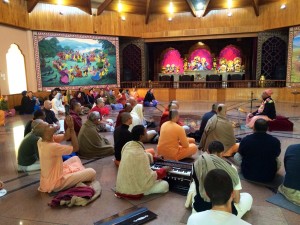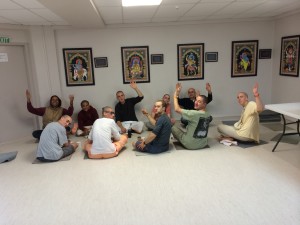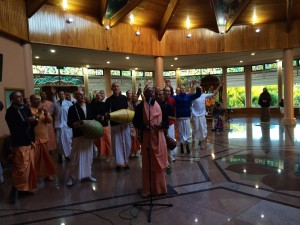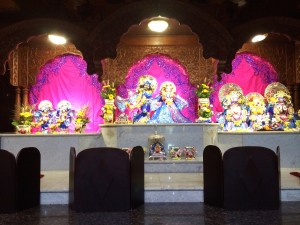by Madhava Smullen
It’s 7:30 on a February morning at New Vrindaban. The sun rises into an orange sky, setting the leafless silhouettes of the trees ablaze and giving the snow packed on the rooftops a golden hue. Devotees crunch over the snow to the temple for Deity Greeting, wrapped up warmly with shoulders hunched against the crisp cold.
Head pujari Abhinanda Das is dressing Sri Sri Radha-Vrindabanchandra this morning. He’s already been up for four-and-a-half hours – since 3:00am. Deity worship services will continue until 8:30pm, and he’s not likely to go to sleep until 10:30 at night.
“I have to find time to chant my rounds, too,” he says, grinning.
Abhinanda is part of an international group of new pujaris working hard alongside an existing team of senior devotee priests to maintain and increase the high standard of worship. For him, being a pujari at New Vrindaban is an adventure — a challenge, but blissful as well.
He began the adventure when he moved from his native Mauritius, where he served for many years as temple commander and pujari, in May 2012. “I had heard a lot about New Vrindaban, and wanted to have a new experience,” he says.
Abhinanda was followed later in 2012 and 2013 by Gopalila Dasi from Russia, Lalita Kunda Dasi from Mexico, Kumari Dasi from Peru, and fellow Mauritian Mangala Charan Dasi. They join many long-time residents of New Vrindaban to create a team of about twenty pujaris.
Having that many priests might seem like a luxury, but at New Vrindaban it’s more of a necessity – no fewer than 24 Deities reside on its intricate golden altars.
Back in the 1970s, when the community consisted of multiple villages called Bahulaban, Madhuban, Guruban, and the original Vrindaban farmhouse, each worshipped their own sets of Deities — which explains why there are so many today.
At the center of the temple room are Radha-Vrindabanchandra. The first officially installed Deities in New Vrindaban, They appeared at the original New Vrindaban farmhouse on Janmastami 1971 and moved to the current temple when it opened in 1983.
The other large Deities are Gaura-Nitai, Gopalnathji, Prahlad-Nrsimha – the largest Nrsimhadeva Deity in North America – Srila Prabhupada, and Jagannath, Baladeva and Subhadra, Who were carved by Nara Narayana Das in the early 1970s from a New Vrindaban tree.
Along with them are Radha-Vrindabannath, Radha-Madhava, and Laksmi Nrsimha, Shalagram and Dwarka Shilas, and smaller forms of Radha-Vrindabanchandra, Gaura Nitai and Prabhupada.
To care for all these Deities at a level befitting the Lord is a superhuman feat, making a New Vrindaban pujari’s day long and absolutely jam-packed.
After rising and showering by 3:30am they wake the Deities, offer Them a variety of milk sweets and then offer Mangala-arati at 5:00am. They then prepare jewellery, dress all the Deities, and offer Sringar-arati at 7:30am.
“At 8:00am we offer a breakfast of three different varieties of fruits, along with malpura, paratha, samosa, and orange juice or, in the winter, home-made herbal tea,” says Abhinanda.
There’s another arati at 8:30, then the Raj Bhoga arati at 12:30pm and an offering consisting of 12 to 14 different preparations, after which pujaris put the Deities to rest at 1:00pm.
At 3:30, they wake Their Lordships up again, and there are more elaborate food offerings and aratis at 4:00pm, 4:30, and 6:15. After Sandhya arati at 7:00pm, the Deities are dressed in Their evening outfits, and a final arati is offered at 8:30, before the Deities take rest for the night.
In between all of this, pujaris must make garlands, cook the various offerings, and chant their sixteen rounds of japa. Abhinanda has the added responsibility of organizing the pujari schedule and finding replacements for pujaris who are ill or have emergencies.
At the end of the day, most pujaris fall exhausted into bed at 10 or 10:30 at night, and sleep for about five hours before getting up and doing it all over again.
In the winter, when many devotees leave for warmer climates and the pujari department is halved in size, there is even more work for everyone: each pujari must dress two sets of Deities. And with the deep snow making travel difficult for those who commute, and temperatures falling to minus ten degrees, things are tough – especially for Abhinanda, who hails from a tropical island.
But here’s the unique thing about Deity worship. Despite all these challenges, Abhinanda loves his service. And surprisingly, he especially loves it during the winter.
“It’s hectic, but very blissful, because we get so many opportunities to serve the Lord,” he says. “In summer, when there are lots of devotees, you don’t always get the chance to dress all the Deities. But in winter, you get the chance to serve Them all. So you develop a relationship with the Lord, and feel closer to Him. And the more you serve the Lord, the happier you become.”
Winter brings other benefits. “Because we are just a small team, we become very close to each other,” says Abhinanda. “With so much snow outside, we tend not to go anywhere, and so our focus is just on our chanting, and on our service. We become very close to each other, and a family mood is created. That’s what I really relish – that family mood amongst the devotees.”
Of course, Deity worship is sweet all year around too, particularly during New Vrindaban’s many festivals. Abhinanda remembers being in an especially blissful mood during Govardhana Puja, when the lecture by Varshana Swami, kirtan and abhishek were especially ecstatic; and during Gaura Purnima, when he and his team spent the previous day creating flower outfits until two o’clock in the morning, and then began dressing the Deities at 5:30am.
“I got to dress Lord Chaitanya myself,” he says. “It was really something to remember – a wonderful spiritual experience.”
The Swan Festival, during which the Deities ride a Swan boat every Saturday throughout the summer, is another highlight. So, too, is the Pushpa Abhishek festival, introduced in 2011 and held every July, during which pujaris shower the Deities with 25 baskets of flower petals.
“Then we go up into the temple room dome, and pour the petals that have bathed the Deities down onto the devotees,” Abhinanda says. “And they pick up whatever petals fall on the floor and start throwing them at each other!”
Abhinanda also appreciates his pujari work because it pervades all areas of his life and helps him to develop brahminical qualities.
“Because you have to maintain a fixed schedule, it helps you become very regulated and focused,” he says. “And because you’re always touching the Lord and have to be very clean, it helps you keep your room, clothes and body clean. It helps you become clean internally too, because you’re constantly thinking about the Lord.”
Abhinanda has also become attached to the place where he serves the Lord. “For me, New Vrindaban is very special, because it was such an important project for Srila Prabhupada, and because some of the Deities were installed when he was physically present,” he says. “And of course it’s wonderful to be serving in a community where you can have the association of so many senior Prabhupada disciples.”
Moving on into the future, Abhinanda hopes to improve the standard of worship, punctuality, and cleanliness at the New Vrindaban Pujari Department. He personally guides the pujaris in this, encouraging them to repeatedly study and apply the New Vrindaban Deity Worship Manual, which was approved by the Mayapur Academy of Deity Worship. He also encourages pujaris to approach him at any time if they’re having any difficulties.
“My vision is to reach high standards like that of Mayapur,” he says. “It’s not going to happen today or tomorrow. But New Vrindaban has great potential.”
But the most important element in reaching this standard, Abhinanda feels, is creating a stable department that leaves behind the ups and downs of the past and runs peacefully and smoothly.
“I want to create a good team, and a good mood amongst the pujaris,” he says. “I feel strongly that this family mood of caring, cooperation and being supportive of one other is very important, and is the real mood of Vaishnavas.”










 Hare Krisna Spain Guadalajara
Hare Krisna Spain Guadalajara  Houston Temple Grand Opening & Radha Giridhari Installation Ceremony (Day 1)
Houston Temple Grand Opening & Radha Giridhari Installation Ceremony (Day 1)  “‘In this Age of Kali there is no religious principle other than the chanting of the holy name, which is the essence of all Vedic hymns. This is the purport of all scriptures.’
purport: ...Since Krishna and His holy name are identical, the holy name is eternally pure and beyond material contamination. It is the Supreme Personality of Godhead as a transcendental vibration. The holy name is completely different from material sound, as confirmed by Narottama dasa Thakura: golokera prema-dhana, hari-nama-sankirtana. The transcendental vibration of hari-nama-sankirtana is imported from the spiritual world. Thus although materialists who are addicted to experimental knowledge and the so-called “scientific method” cannot place their faith in the chanting of the Hare Krishna maha-mantra, it is a fact that simply by chanting the Hare Krishna mantra offenselessly one can be freed from all subtle and gross material conditions.
“‘In this Age of Kali there is no religious principle other than the chanting of the holy name, which is the essence of all Vedic hymns. This is the purport of all scriptures.’
purport: ...Since Krishna and His holy name are identical, the holy name is eternally pure and beyond material contamination. It is the Supreme Personality of Godhead as a transcendental vibration. The holy name is completely different from material sound, as confirmed by Narottama dasa Thakura: golokera prema-dhana, hari-nama-sankirtana. The transcendental vibration of hari-nama-sankirtana is imported from the spiritual world. Thus although materialists who are addicted to experimental knowledge and the so-called “scientific method” cannot place their faith in the chanting of the Hare Krishna maha-mantra, it is a fact that simply by chanting the Hare Krishna mantra offenselessly one can be freed from all subtle and gross material conditions.  Lord Sri Krishna Caitanya is the initiator of sankirtana [congregational chanting of the holy name of the Lord]. One who worships Him through sankirtana is fortunate indeed.
Such a person is truly intelligent, whereas others, who have but a poor fund of knowledge, must endure the cycle of repeated birth and death. Of all sacrificial performances, the chanting of the Lord’s holy name is the most sublime.
Lord Sri Krishna Caitanya is the initiator of sankirtana [congregational chanting of the holy name of the Lord]. One who worships Him through sankirtana is fortunate indeed.
Such a person is truly intelligent, whereas others, who have but a poor fund of knowledge, must endure the cycle of repeated birth and death. Of all sacrificial performances, the chanting of the Lord’s holy name is the most sublime.  It is our great pleasure to report that a group of devotees from Sarajevo distributed prasadam to the flood victims from the municipality of Vogosca, Sarajevo Canton, today. Devotees collected donations amongst ourselves, then purchased the bhoga, cooked, transported and served Kitchri, bread, salad and drinking water to 73 of our fellow citizens, who were located in three collective centers in the municipality of Vogosca. After our mission at motel Beslic, there were media crews from TVSA and BH Radio 1 to which our spokesperson Amala Prema dd gave statements, even live in the radio program. We did not expect any media promotion or worked for it, but it was obvious that Krishna wanted it to promote efforts of his devotees.
It is our great pleasure to report that a group of devotees from Sarajevo distributed prasadam to the flood victims from the municipality of Vogosca, Sarajevo Canton, today. Devotees collected donations amongst ourselves, then purchased the bhoga, cooked, transported and served Kitchri, bread, salad and drinking water to 73 of our fellow citizens, who were located in three collective centers in the municipality of Vogosca. After our mission at motel Beslic, there were media crews from TVSA and BH Radio 1 to which our spokesperson Amala Prema dd gave statements, even live in the radio program. We did not expect any media promotion or worked for it, but it was obvious that Krishna wanted it to promote efforts of his devotees.  400 meals was distributed in worst flooded city Obreonovac. Police shifted us over the water to blocked parts of the city. Thank you all for the support and help!
400 meals was distributed in worst flooded city Obreonovac. Police shifted us over the water to blocked parts of the city. Thank you all for the support and help!  Learn Anasuya's history in her first video "Just Saved From Slaughter" at: http://youtu.be/Ak5BM5XQUsM
Anasuya was so happy to get out of the barn and onto the pasture. She ran, jumped and kicked her heels in joy. The winter was long and harsh and the warm temperatures and green grass were like heaven. She may be a little hesitant when meeting new people but not very much and charmed some students from Hanover College when they came for a visit to the ISCOWP farm. She also is kind as we learned when we put Gourangi in the Old Cow Shelter that Anasuya and Indraneela were using. Anasuya stuck close as Gourangi passed away. Healthy and pretty (who would have known by the way she looked when she was rescued), Anasusya is living the good life at the ISCOWP farm as a protected cow.
Learn Anasuya's history in her first video "Just Saved From Slaughter" at: http://youtu.be/Ak5BM5XQUsM
Anasuya was so happy to get out of the barn and onto the pasture. She ran, jumped and kicked her heels in joy. The winter was long and harsh and the warm temperatures and green grass were like heaven. She may be a little hesitant when meeting new people but not very much and charmed some students from Hanover College when they came for a visit to the ISCOWP farm. She also is kind as we learned when we put Gourangi in the Old Cow Shelter that Anasuya and Indraneela were using. Anasuya stuck close as Gourangi passed away. Healthy and pretty (who would have known by the way she looked when she was rescued), Anasusya is living the good life at the ISCOWP farm as a protected cow.  Vivāha-yajña, the marriage ceremony, is meant to regulate the human mind so that it may become peaceful for spiritual advancement. For most men, this vivāha-yajña should be encouraged even by persons in the renounced order of life. Sannyāsīs should never associate with women, but that does not mean that one who is in the lower stages of life, a young man, should not accept a wife in the marriage ceremony. All prescribed sacrifices are meant for achieving the Supreme Lord. Therefore, in the lower stages, they should not be given up.
Vivāha-yajña, the marriage ceremony, is meant to regulate the human mind so that it may become peaceful for spiritual advancement. For most men, this vivāha-yajña should be encouraged even by persons in the renounced order of life. Sannyāsīs should never associate with women, but that does not mean that one who is in the lower stages of life, a young man, should not accept a wife in the marriage ceremony. All prescribed sacrifices are meant for achieving the Supreme Lord. Therefore, in the lower stages, they should not be given up.
 Mariachi is a form of folk music from Mexico.
Mariachi is a form of folk music from Mexico.  Many thanks to all who organized and participated in the kirtan!
Many thanks to all who organized and participated in the kirtan!  Merciful devotees from Iskcon Wellington distribute Srila Prabhupada's books!
Merciful devotees from Iskcon Wellington distribute Srila Prabhupada's books! 